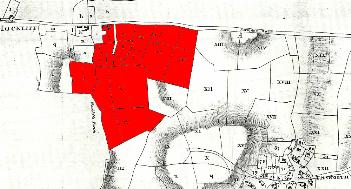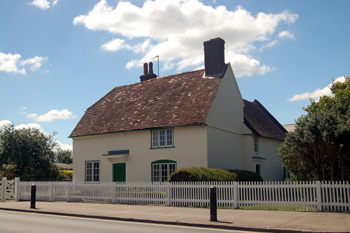Bull Farm Hockliffe

Bull Farm in 1804 [note that the top of the map is north-east instead of north]
Virtually all of Tilsworth was owned by Tilsworth Manor until the 19th century. In the Tilsworth Estate sale particulars of 1804 [AD534/4], Bull Farm was tenanted by William Arrowsmith and comprised the Bull Inn and a total of 136 acres 1 rood of land.
- Smarridoles; arable 19 acres 1 rood 19 perches; meadow 8 acres 3 roods 33 perches;
- White's Piece; arable 22 acres 3 roods 35 perches; meadow 9 acres 3 roods 3 perches;
- Seuids; arable 15 acres 2 roods 7 perches; meadow 3 acres 1 rood 38 perches;
- Great Standford; arable 16 acres 34 perches; meadow 5 acres 3 roods 28 perches;
- Middle Meadow; 3 acres 21 perches;
- Dovington Meadow; 2 acres 2 roods 32 perches;
- Little Dovington; 2 acres 36 perches;
- Three-cornerned Piece; 4 acres 13 perches;
- Middle Close; 4 acres 1 rood 32 perches;
- Home Close; 2 acres 1 rood 18 perches;
- The Bull Inn [and farmhouse];
- Jenkins' Close; 4 acres 1 rood 29 perches;
- Horse Shoe Close; 6 acres 3 roods 18 perches;
- Little Standford; 2 acres 2 roods 14 perches;

Bull Farm June 2008
In 1917 Britain was facing starvation as the unrestricted U-Boat campaign by Germany was sinking large quantities of merchant shipping. The situation was every bit as bad as during parts of World War Two. Part of the government response was to order grassland to be ploughed up for arable crops. Naturally, the farmer usually objected as the ground thus used was often marginal at best. At that stage Frederic Augustus Page-Turner still owned the farm, which was farmed by John Olney who put in an objection when told to break up Road Crouch (XIII on the 1804 sale map) and plough 15.830 acres of it [WW1/AC/OP2/96].
The Rating and Valuation Act 1925 ordered every piece of land and building in the country to be assessed to determine the rates to be paid on it. The valuer visiting Bull Farm [DV1/H28/62] noted that it was owned and occupied by owner/occupier John Olney, who had evidently bought the farm from the Tilsworth Estate since 1917. The farm then comprised 207 acres. The valuer commented: "Talked to him in field. Good homestead. Nice house but on Watling Street"
The farmhouse was described as brick and tile containing three reception rooms, a kitchen, scullery, cellar and dairy with four bedrooms and an attic above. The outbuildings were as follows:
- West Yard: a brick and tile dairy; a coal barn; a stable for four horses; a cow house for five; a cow house for nine used as a piggery; a feeding hovel; a brick and slate large barn; a wood, brick and slate open cow house for nine; a cow house for eleven; a granary; a large calf box with a loft over; a stable for seven with a loft over; a chaff place with a loft over;
- At the rear: a wood, brick and slate five bay open implement shed; a hen house; a two bay open cart shed used as a wood store; a trap house; a five bay open cart shed;
- In the meadow: a corrugated iron and thatch implement shed.
The farmhouse was listed by the former Department of Environment as Grade II, of special interest. It was considered to be an 18th century building, constructed of brick which had been colourwashed and a half-hipped old clay tile roof. The property has two storeys. The property shows no signs today of ever having been an inn. The property used to be in the parish of Tilsworth but following boundary changes in the 20th century is now in Hockliffe.